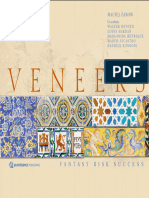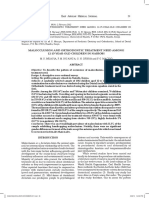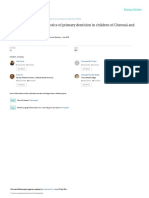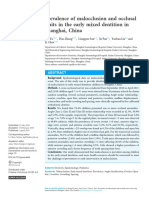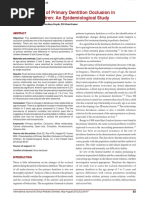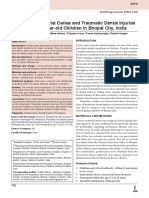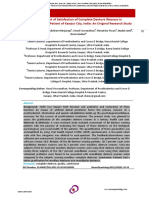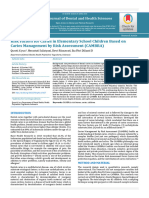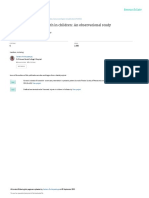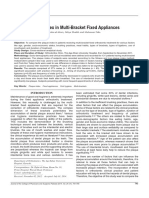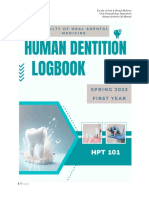Articulo 12
Articulo 12
Uploaded by
lyes BrionesCopyright:
Available Formats
Articulo 12
Articulo 12
Uploaded by
lyes BrionesOriginal Title
Copyright
Available Formats
Share this document
Did you find this document useful?
Is this content inappropriate?
Copyright:
Available Formats
Articulo 12
Articulo 12
Uploaded by
lyes BrionesCopyright:
Available Formats
See discussions, stats, and author profiles for this publication at: https://www.researchgate.
net/publication/346032242
Occlusal Characteristics of Primary Dentition among School Going Children
Article in Journal of Nepal Health Research Council · November 2020
DOI: 10.33314/jnhrc.v18i3.2237
CITATIONS READS
0 277
6 authors, including:
Amita Rai Bandana Koirala
People's Dental College and Hospital B.P. Koirala Institute of Health Sciences
19 PUBLICATIONS 6 CITATIONS 52 PUBLICATIONS 135 CITATIONS
SEE PROFILE SEE PROFILE
Mamta Dali Sneha Shrestha
B.P. Koirala Institute of Health Sciences B.P. Koirala Institute of Health Sciences
54 PUBLICATIONS 71 CITATIONS 41 PUBLICATIONS 22 CITATIONS
SEE PROFILE SEE PROFILE
Some of the authors of this publication are also working on these related projects:
Knowledge, awareness and attitude regarding dental implants among undergraduate dental students of Nepal: All Nepal Survey. View project
Prevalence of Agenesis of Mandibular Third Molars in A Tertiary Healthcare Center of Nepal View project
All content following this page was uploaded by Amita Rai on 20 November 2020.
The user has requested enhancement of the downloaded file.
Original article
J Nepal Health Res Counc 2020 Jul-Sep;18(48): 386-93
DOI: https://doi.org/10.33314/jnhrc.v18i3.2237
Occlusal Characteristics of Primary Dentition among
School Going Children
Amita Rai,1 Bandana Koirala,2 Mamta Dali,2 Sneha Shrestha,2 Ashish Shrestha,3 Surya Raj Niraula4
1
Dental department, Kanti Children’s Hospital, Maharajgunj, Kathmandu, Nepal, 2Department of
Pedodontics and Preventive Dentistry, College of Dental Surgery, B.P. Koirala Institute of Health Sciences,
Dharan, Nepal, 3Department of Public Health Dentistry, College of Dental Surgery, B.P. Koirala Institute of
Health Sciences, Dharan, Nepal, 4School of Public Health and Community Medicine, B.P. Koirala Institute of
Health Sciences, Dharan, Nepal.
ABSTRACT
Background: Certain characteristics of the primary dentition have been described that may be required in the
smooth transition from primary to permanent dentition and therefore development of ideal occlusion in permanent
dentition. The objectives of this study were to assess different occlusal characteristics of primary dentition among
school going children of Dharan, Nepal and to compare these occlusal characteristics based on gender and race.
Methods: A community based cross-sectional study was conducted among 625 school children of Mongolian and
Caucasian race, aged 3 to 7 years, and having complete set of primary dentition. A close-ended questionnaire was
developed to gather demographic information followed by the examination of occlusal and soft tissue parameters.
Results: The result showed 77.2% of the children had developmental spaces and 83.1% had primate spaces. Flush
terminal plane molar and class I canine relationships were present in 68.8% and 81.6%, respectively with normal
overjet (53.5%), normal overbite (41.1%), straight facial profile (86.7%) and competent lips (98.6%). Crowding was
present in 35.4%, midline discrepancy in 11.3%, crossbite in 7.2%, scissor bite in 0.6% and open bite in 2.1% of the
children examined.
Conclusions: Most of the occlusal characteristics were desirable but with the existence of some malocclusion
traits, necessitating timely recognition and correction through early screening. Gender and racial influences were also
observed and it emphasizes the need for treatment plan based on them.
Keywords: Gender; occlusal characteristics; primary dentition; race
INTRODUCTION duration and cost.
Certain characteristics of the primary dentition like Although few studies deciphering the occlusal
presence of developmental spaces, primate spaces, flush characteristics have been reported, racial variation of
terminal plane, class I incisors and canines relationship occlusal characteristic have not been studied. Hence,
are required in the smooth transition from primary to the objectives of this study were to assess the different
permanent dentition and therefore development of occlusal characteristics of primary dentition among
ideal occlusion.1,2 school going children of Dharan, and to compare the
distribution of occlusal characteristics based on gender
Malocclusion traits present in primary dentition will be and race.
reflected or worsened in permanent dentition.1 This
study will help in early recognition of malocclusion in METHODS
primary dentition and implementation of preventive
treatment strategies, which helps in eliminating or A community based cross-sectional study was conducted
reducing the severity of malocclusion in permanent in randomly selected nine different schools of Dharan
dentition, thereby reducing the orthodontic treatment sub-metropolitan city, within a period of 15th March-
Correspondence: Dr Amita Rai, Dental Department, Kanti Children’s Hospital,
Maharajgunj, Kathmandu, Nepal. Email: amitarai2013@gmail.com, Phone:
+9779819203326.
386 JNHRC Vol. 18 No. 3 Issue 48 Jul - Sep 2020
Occlusal Characteristics of Primary Dentition among School Going Children
31st December 2017. Children studying in Nursery to While recording crossbite, anterior cross bite was re-
class one were enrolled in the study using purposive corded when one or more of the maxillary incisors and/
sampling method. Ethical approval was obtained from or canines occluded lingually to the mandibular incisors.
the Institutional Review Committee. Informed consent Posterior cross bite was recorded when one or more
was obtained from parents or their legal guardian, and of the maxillary molars occluded lingual to the buccal
assent was obtained from the children involved in the cusps of the opposing mandibular teeth.9,11-13Scissor bite
study. was recorded when lingual cusps of one or more maxil-
lary molars occluded buccally to the buccal surfaces of
Participants with complete set of primary dentition corresponding mandibular teeth.9,11
belonging to Mongolian and Caucasian race were included
in the study. Children with fractured, anomalous, grossly Overjet was recorded as the linear measurement in
decayed tooth/teeth; cleft of lip/palate; history of millimeters between labial surfaces of the maxillary and
orthodontic treatment and parents/children not willing mandibular central incisors in centric occlusion, with
to participate in the study were excluded. The study the help of a stainless-steel scale. Overjet was graded
population was categorized as Mongolian and Caucasian as: 0–2 mm, 2–4 mm and >4 mm.1,8,9
race according to Ethnicity.3,4 The sample size consisted
of 625 children (95 percent confidence interval=1.96, While recording overbite, labial surface of the
permissible error of 14% and 10% for non-response), mandibular central incisor was marked with a sharp
which was estimated based on the prevalence of pencil at the level of the incisal edge of the maxillary
developmental spaces in the mandibular arch (25.7%) central incisor in centric occlusion. The distance of this
from the study conducted by Bhayya & Shyagali.1 mark from the incisal edge of the mandibular central
incisor was measured as overbite with the help of a
Training and calibration was conducted for the examiner stainless-steel scale. Over-bite was graded as: 1–2 mm,
by an expert. An intra-examiner reliability test was 2–4 mm and >4 mm.1,9
performed by examining a group of 25 children, at two
different time periods of one week apart. Cohen’s Kappa While recording open bite, anterior open bite was
statistical analysis revealed that the Kappa coefficient recorded as the reverse of an overbite, with lack of
for various occlusal characteristics ranged from 0.80 to occlusion of anterior teeth. Posterior open bite was
0.82. recorded when there was lack of occlusion of the
posterior teeth.1,8,9
A questionnaire addressing demographic data to
characterize the sample and history of orthodontic Soft tissue parameters recorded were; facial profile and
treatment was sent to parents/legal guardians. Occlusal lip competency. Facial profile was recorded as; straight,
characteristics of the participant was examined by a when maxilla was properly oriented relative to other
single examiner under natural day-light. Each child was skeletal structures, base of the upper lip was on or near
asked to sit on a chair and the entire oral cavity was the vertical line, soft tissue chin was slightly behind
visualized using mouth mirror no. 4 and straight probe. the reference line, and the mandible was of proper size
and in the correct position; convex, when maxilla was
Occlusal parameters measured were; developmental positioned significantly in front of the vertical reference
spaces, primate spaces, crowding, molar relationship, line and if mandible was positioned significantly behind
canine relationship, midline discrepancy, crossbite, the vertical reference line or if both condition were
scissor bite, overjet, overbite and open bite. present; concave, when maxilla was substantially
behind the vertical reference line and if mandible was
Developmental spaces were recorded as any space other positioned significantly in front of the vertical reference
than primate spaces between the primary teeth. Primate line or if both condition were present.5,12,13
spaces were recorded as spaces between primary lateral
incisor and canine in the maxillary arch, and spaces Lip competency was recorded as competent when both
between the primary canine and the first molar in the upper and lower lips were in contact with each other,
mandibular arch.5-7Crowding was recorded when incisors and incompetent when separated by more than 3-4 mm
showed signs of overlapping or rotation or complete lack at rest. 14,15
of space. 1,5,8Midline discrepancy was assessed by using a
dental floss, passing from the forehead along the midline Collected data was entered into Microsoft Excel 2008
of the nose, down to the chin while the child parted the and converted into Statistical Package for the Social
lips and the dentition was in centric occlusion. 9,10 Sciences (SPSS) 11.0 version for statistical analysis. For
JNHRC Vol. 18 No. 3 Issue 48 Jul - Sep 2020 387
Occlusal Characteristics of Primary Dentition among School Going Children
descriptive statistics, mean, standard deviation and per- (31.3%) had significantly higher prevalence of maxillary
centage were calculated. The comparison of categorical primate spaces as compared to males (22.4%) (P=0.012),
data was done using Chi square or Fisher’s Exact test. whereas, primate spaces in both arches was significantly
Fisher’s exact test was used when cells had expected higher in males (58.1% vs 44.9%) (P=0.001). Crowding was
count of less than 5. Probability of significance was set absent in 64.6% of the children. There was significant
at 95% confidence interval, where p≤0.05. association (P<0.005) between presence of mandibular
crowding (22.8% vs 14.2%), absence of crowding (69.7%
RESULTS vs 58.1%), and gender. The prevalence of midline
discrepancy was 11.3% (Table 2).
A total of 625 children were examined among which
56.5% were male and 43.5% were female. Race wise Majority of the children had flush terminal plane
61.1% were Mongolian and 38.9% were Caucasian (Table molar (68.8%), and class I canine (81.6%) relationships.
1). Mesial step molar relationship was significantly higher
(P=0.015) in Mongolian (29.3%) as compared to Caucasian
Table 1. Gender and race wise distribution of the study (20.6%) children. There was significant association
sample.
between class III (12.3% vs 4.9%) (P=0.002), asymmetric
Gender canine relationship (3.7% vs 1.3%) (P=0.049) and race.
Frequency
Race
(%) Male (%) Female (%) Anterior crossbite was significantly higher (P=0.005) in
Mongolian children (7.9% vs 2.5%). Overjet of 0-2 mm
Mongolian 382 (61.1) 216 (56.5) 166 (43.5) was significantly higher in Mongolian (57.9% vs 46.1%)
Caucasian 243 (38.9) 137 (56.4) 106 (43.6) (P=0.004), whereas, >4 mm overjet was significantly
Total 625 (100) 353 272 higher in Caucasian (8.2% vs 3.1%) (P=0.005)(Table 3).
Developmental spaces were present in 77.2% of the Majority of the children had acceptable overbite (1-2
children examined. Males had significantly higher mm: 41.1%, 2-4 mm: 48.3%). Only 2.1% of the children
prevalence of developmental spaces in both arches (56.9% examined had open bite (Table 4).
vs 44.9%) (P=0.003) as compared to females, whereas,
Majority of the children had straight facial profile
absence of developmental spaces was significantly
(86.7%) and competent lips (98.6%)(Table 5).
higher in females (26.8 % vs 19.8%) (P=0.039). Primate
spaces was present in 83.1% of the children. Females DISCUSSION
Table 2. Prevalence of intra-arch alignment and midline discrepancy, and comparison according to gender and
race.
Gender Race
Frequency Male (%)
(%) N=625 Female (%) p-value Mongolian (%) Caucasian (%) p-value
N=272 N=382 N=243
N=353
Developmental spaces
Maxillary 91 (14.6) 44 (12.5) 47 (17.3) 0.091 59 (15.4) 32 (13.2) 0.432
Mandibular 68 (10.9) 38 (10.8) 30 (11.0) 0.916 42 (11.0) 26 (10.7) 0.908
Both arches 323 (51.7) 201 (56.9) 122 (44.9) 0.003 *
194 (50.8) 129 (53.1) 0.575
Absent 143 (22.9) 70 (19.8) 73 (26.8) 0.039 *
87 (22.8) 56 (23.0) 0.937
Primate spaces
Maxillary 164 (26.2) 79 (22.4) 85 (31.3) 0.012* 108 (28.3) 56 (23.0) 0.148
Mandibular 29 (4.6) 15 (4.2) 14 (5.1) 0.597 19 (5.0) 10 (4.1) 0.619
Both arches 327 (52.3) 205 (58.1) 122 (44.9) 0.001 *
191 (50.0) 136 (56.0) 0.145
Absent 105 (16.8) 54 (15.3) 51 (18.8) 0.252 64 (16.8) 41 (16.9) 0.969
Crowding
Maxillary 26 (4.2) 14 (4.0) 12 (4.4) 0.782 16 (4.2) 10 (4.1) 0.964
388 JNHRC Vol. 18 No. 3 Issue 48 Jul - Sep 2020
Occlusal Characteristics of Primary Dentition among School Going Children
Mandibular 112 (17.9) 50 (14.2) 62 (22.8) 0.005* 71 (18.6) 41 (16.9) 0.586
Both arches 83 (13.3) 43 (12.2) 40 (14.7) 0.356 50 (13.1) 33 (13.6) 0.860
Absent 404 (64.6) 246 (69.7) 158 (58.1) 0.003 *
245 (64.1) 159 (65.4) 0.741
Midline discrepancy
Maxillary 11 (1.8) 8 (2.3) 3 (1.1) 0.273 7 (1.8) 4 (1.6) 1.000
Mandibular 56 (9.0) 32 (9.1) 24 (8.8) 0.916 34 (8.9) 22 (9.1) 0.948
Both 3 (0.5) 1 (0.3) 2 (0.7) 0.583 f
1 (0.3) 2 (0.8) 0.563f
Absent 555 (88.8) 312 (88.4) 243 (89.3) 0.708 340 (89.0) 215 (88.5) 0.838
*Statistically Significant; Fisher’s exact test
f
Table 3. Prevalence of sagittal and transverse occlusal parameters, and comparison according to gender and race.
Gender Race
Frequency Male (%)
Female (%) p-value Mongolian Caucasian p-value
(%) N=625
N=272 (%) N=382 (%) N=243
N=353
Molar relationship
Flush 430 (68.8) 243 (68.8) 187 (68.8) 0.981 253 (66.2) 177 (72.8) 0.082
Mesial Step 162 (25.9) 94 (26.6) 68 (25.0) 0.645 112 (29.3) 50 (20.6) 0.015*
Distal Step 21 (3.4) 8 (2.3) 13 (4.8) 0.084 13 (3.4) 8 (3.3) 0.940
Asymmetric 12 (1.9) 8 (2.3) 4 (1.5) 0.472 4 (1.0) 8 (3.3) 0.090
Canine relationship
Class I 510 (81.6) 291 (82.4) 219 (80.5) 0.539 307 (80.4) 203 (83.5) 0.318
Class II 42 (6.7) 23 (6.5) 19 (7.0) 0.816 23 (6.0) 19 (7.8) 0.381
Class III 59 (9.4) 29 (8.2) 30 (11.0) 0.233 47 (12.3) 12 (4.9) 0.002*
Asymmetric 14 (2.2) 10 (2.8) 4 (1.5) 0.254 5 (1.3) 9 (3.7) 0.049*
Crossbite
Anterior 36 (5.8) 20 (5.7) 16 (5.9) 0.908 30 (7.9) 6 (2.5) 0.005*
Posterior unilateral 7 (1.1) 4 (1.1) 3 (1.1) 1.000f 3 (0.8) 4 (1.6) 0.440f
Posterior bilateral 2 (0.3) 1 (0.3) 1 (0.4) 1.000f 0 (0.0) 2 (0.8) NA
Absent 580 (92.8) 328 (92.9) 252 (92.6) 0.897 349 (91.4) 231 (95.1) 0.081
Scissor bite
Present 4 (0.6) 3 (0.8) 1 (0.4) 4 (1.0) 0 (0.0)
0.636f NA
Absent 621 (99.4) 350 (99.2) 271 (99.6) 378 (99.0) 243 (100)
Overjet
0-2 mm 333 (53.5) 197 (55.8) 136 (50.0) 0.149 221 (57.9) 112 (46.1) 0.004*
2-4 mm 260 (41.6) 142 (40.2) 118 (43.4) 0.427 149 (39.0) 111 (45.7) 0.099
>4 mm 32 (5.1) 14 (4.0) 18 (6.6) 0.136 12 (3.1) 20 (8.2) 0.005*
Table 4. Prevalence of vertical occlusal parameters and comparison according to gender and race.
Gender Race
Frequency(%)
Male (%) Female (%) p-value Mongolian(%) Caucasian(%) p-value
N=625
N=353 N=272 N=382 N=243
Overbite
JNHRC Vol. 18 No. 3 Issue 48 Jul - Sep 2020 389
Occlusal Characteristics of Primary Dentition among School Going Children
1-2 mm 257 (41.1) 151 (42.8) 106 (39.0) 0.338 162 (42.4) 95 (39.1) 0.412
2-4 mm 302 (48.3) 164 (46.5) 138 (50.7) 0.289 186 (48.7) 116 (47.7) 0.816
>4 mm 66 (10.6) 38 (10.8) 28 (10.3) 0.849 34 (8.9) 32 (3.2) 0.091
Open bite
Anterior 11 (1.8) 9 (2.5) 2 (0.7) 0.161 7 (1.8) 4 (1.6) 1.000
Posterior 2 (0.3) 1 (0.3) 1 (0.4) 1.000f 1 (0.3) 1 (0.4) 1.000f
No open bite 612 (97.9) 343 (97.2) 269 (98.9) 0.223 374 (97.9) 238 (97.9) 0.975
Table 5. Prevalence of soft tissue parameters and comparison according to gender and race.
Gender Race
Frequency(%)
Male (%) Female (%) p-value Mongolian(%) Caucasian(%) p-value
N=625
N=353 N=272 N=382 N=243
Facial profile
Straight 542 (86.7) 307 (87.0) 235 (86.4) 0.835 330 (86.4) 212 (87.2) 0.759
Convex 66 (10.6) 36 (10.2) 30 (11.0) 0.737 39 (10.2) 27 (11.1) 0.721
Concave 17 (2.7) 10 (2.8) 7 (2.6) 0.843 13 (3.4) 4 (1.6) 0.287
Lip competency
Competent 616 (98.6) 346 (98.0) 270 (99.3) 378 (99.0) 238 (97.9)
0.337 0.491
Incompetent 9 (1.4) 7 (2.0) 2 (0.7) 4 (1.0) 5 (2.1)
In the present study, 77.2% of the children presented The present study reveals that 68.8% of the children
with developmental spaces. Majority of the children had flush terminal plane which indicates the normal
had developmental spaces in both the arches (51.7%) development of both arches. Mesial step, distal step
indicating the normal development which was preferable. molar relationships were present in 25.9% and 3.4% which
Among the children examined, 22.9% revealed absence suggest the chance of class I or class III molar relationship
of developmental spaces which reflects the possibility of and class II malocclusion, respectively in the permanent
crowding in the permanent dentition of those children. dentition. The distribution of molar relationship was
Overall prevalence of the developmental spaces in comparable to the study done by Shavi et al.20 in Indian
the present study was in agreement with the findings children, Otuyemi et al.,19 and Onyeaso & Sote21 in
of Zakirulla in Saudi Arabian16 but higher (61.1%) Nigerian Children. Prevalence of flush (55.35%) terminal
as compared to the studies by Bhayya & Shyagali1, plane was higher but mesial step (43.34%) terminal
Fernandes et al. (56.7%)17 in Indian, and Zhou et al. plane was lower as compared to the study done by Baral
(44.8%)18 in Chinese children. et al.22 in Nepalese children residing in Kaski district.
Prevalence of asymmetric molar relationship was 1.9%
Majority of the children had primate spaces in both the which was comparable to the results in studies of Bhayya
arches (52.3%) which indicates the normal development. & Shyagali1 in Indian and Otuyemi et al.19 in Nigerian
Overall, 83.1% of the children had primate spaces. children. There was significant association between
However, lower prevalence was reported by Bhayya & mesial step molar relationship and race (P=0.015) which
Shyagali (60.5%)1, Fernandes et al. (71.3%)17 in Indian is in agreement with the study of Baral23 done among
and Otuyemi et al. (25.2%)19 in Nigerian children. This Mongolian and Aryan population of eastern Nepal with
variations could be due to the differences in the ethnicity permanent dentition. This finding may suggest that the
of the population being examined. mesial step molar relationship of our study population
have a probability to develop into class III malocclusion
Crowding of both the arches was present in 13.3% of
in permanent dentition eventually.
the children which predicts the possibility for crowding
in the permanent dentition and this result is lower as Majority of the children had class I canine relationship
compared to the study by Otuyemi et al.19 in Nigerian (81.6%) which indicates the normal development of both
(18.1%), Bhayya & Shyagali (6.3%)1, Fernandes et arches. The prevalence of class I canine relationship
al.(1.3%)17 in Indian, Zhou et al. (6.5%)18 in Chinese and in this study was comparable to the reports of Bhayya
Zakirulla (6%)16 in Saudi Arabian children. & Shyagali1 but higher as compared to the reports of
390 JNHRC Vol. 18 No. 3 Issue 48 Jul - Sep 2020
Occlusal Characteristics of Primary Dentition among School Going Children
Onyeaso & Sote21 (64.7%), Zhou et al.18 (57%) and Abu and Yadav et al. (68.4%)29 whereas, higher prevalence
Alhaija & Qudeimat24 (57%), and lower (95.8%) as of 2-4 mm and >4 mm overjet was higher as compared
compared to the reports of Fernandes et al.17. In the to the study of Bhayya & Shyagali (15.7% and 2.7%)1 and
studies done by Zhou et al. in Chinese18, Abu Alhaija Yadav et al. (12.4% and 0%)29 in Indian children.
& Qudeimat24 in Jordanian, and Bhayya & Shyagali1 in
Indian children, Class II canine relationship was more Open bite was present in 2.1%, showing very low
common than Class III canine relationship but in our prevalence of vertical malocclusion. Anterior open bite
study, class III canine relationship was more common was more common (1.8%) than posterior open bite (0.3%)
that class II. Majority of the children had no midline and the results were similar to the study of Bhayya &
discrepancy which indicates the normal development Shyagali1 and Fernandes et al.17 in Indian children but
of both maxillary and mandibular arches. These findings lower as compared to the study by, Yadav et al. (14.4%)29
were in accordance with the study of Bhayya & Shyagali1 in Indian children. Prevalence of anterior open bite was
in Indian population. comparable to the results of Shah P et al. (1.6%)27 in
the study conducted among Nepalese children residing
In this study, crossbite was found in 7.2%. Cavalcanti25 in in Kathmandu district.
their study showed 18.4% of the Brazilian children with
crossbite which was higher than the result of our study. Straight facial profile was commonest followed by
Prevalence of anterior crossbite in our study (5.8%) was convex, and concave profile (86.7%, 10.6% and 2.7%)
higher as compared to the result of Bhayya et al.26 in which was in accordance with the reports of Yadav et al.
Indian children (1.6%), Baral P et al. (3%)22 in Nepalese (74.8%, 24.4% and 0.8%)29and Fernandes et al. (63.2%,
children residing in Kaski district, and Zakirulla16 in 35.2% and 1.6%)17 in Indian children, but Bhayya &
Saudi Arabian children (0.7%) but lower as compared Shyagali (37.1%, 58.9% and 4%)1 reported convex profile
to the result of Zhou et al.18 in Chinese children (8%). to be more common in their study which was also
Prevalence of anterior crossbite was comparable to the conducted among Indian children. This may be due to
results of Shah P et al. (5.2%)27 in the study conducted ethnic variation in different geographic locations. The
among Nepalese children residing in Kathmandu district. prevalence of lip incompetency in this study (1.4%) was
We found significant association between anterior lesser as compared to the reports of Bhayya & Shyagali
crossbite and race (P=0.005) which is similar to the study (4.5%)1, and Yadav et al. (19.2%)29 in Indian children.
by Baral23 among Mongolian and Aryan population of
CONCLUSIONS
eastern Nepal with permanent dentition suggesting that
the crossbite present in primary dentition might persist
This study showed that most of the occlusal
in succeeding dentition also. Scissor bite was present in
characteristics were desirable but with the existence of
0.6% of the children in our study which was equal to
some occlusal traits that deviate from the norm with
the reports of Bhayya & Shyagali1 in Indian children. In
both the gender and racial influence. These deviations
the present study, none of the Caucasian children had
observed were undesirable as they may ultimately lead
scissor bite whereas, Tschill, Bacon & Sonko28 reported
to the development of malocclusion. These findings
the prevalence in French Caucasian children to be 0.4%.
indicate the need for early screening and correction of
the malocclusion traits, and also emphasizes the need
Overjet of 0-2 mm was commonest (53.5%) followed by
for treatment plan of these children based on their
2-4 mm (41.6%) and >4 mm (5.1%). Overjet of 0-2 mm was
gender and race.
lesser (84.5%) but overjet of 2-4 mm was higher (11.9%)
in comparison to the reports of Bhayya & Shyagali1,
REFERENCES
and Yadav et al.29 (92.4% and 6.4%) in Indian children.
These findings may indicate an absence of deleterious
1. Bhayya DP, Shyagali TR. Gender influence on occlusal
habits or skeletal discrepancies in the majority of the
characteristics of primary dentition in 4- to 6-year-old
children examined. Mongolian children had significantly
children of Bagalkot City, India. Oral Health Prev Dent.
higher prevalence of 0-2 mm overjet (P=0.004) whereas,
2001;9(1):17–27. [PubMed]
Caucasian children had significantly higher prevalence of
>4 mm overjet (P=0.005). 2. Foster TD. The development of the occlusion of the teeth.
In: A Textbook of Orthodontics. 3rd ed. London: Black-
Prevalence of 1-2 mm overbite was 41.1%, 2-4 mm well Scientific Publications. 1991:44-74. [FullText]
was 48.3%, and >4 mm was 10.6%. In present study,
3. Gurung H, Gurung Y, Chidi CL. Nepal atlas of ethnic and
lesser prevalence of 1-2 mm overbite was observed as
caste groups. National foundation for development of in-
compared to the reports by Bhayya & Shyagali (81.6%)1
JNHRC Vol. 18 No. 3 Issue 48 Jul - Sep 2020 391
Occlusal Characteristics of Primary Dentition among School Going Children
digenous nationalities; Sanepa, Lalitpur. 2005. [FullText] children: a cross-sectional study. BJMS. 2012;11(4):343-
6. [FullText]
4. Population monograph of Nepal, Volume 2, Government
of Nepal National Planning Commission Secretariat Cen- 17. Fernandes S, Patel DG, Ranadheer E, Kalgudi J, Santoki J,
tral Bureau of Statistics Ramshah Path, Kathmandu, Nepal. Chaudhary S. Occlusal traits of primary dentition among
2014. [FullText] pre-school children of Mehsana district, North Gujarat,
India. J Clin Diagn Res. 2017;11(1):92–6. [PubMed]
5. Casamassimo PS, McTigue DJ, Fields HW, Nowak AJ.
Examination, Diagnosis, and Treatment Planning. In: Pe- 18. Zhou X, Zhang Y, Wang Y, Zhang H, Chen L, Liu Y.
diatric Dentistry, Infancy through adolescence 5th ed. St. Prevalence of malocclusion in 3-to 5-year-old chil-
Louis Missouri: Elsevier. 2013:258-78. dren in Sanghai, China. Int J Environ Res Public Health.
2017;14(328):1-10. [PubMed]
6. Abu Affan AH, Abd-Alrahman RM. Occlusal character-
istics of primary dentition in Sudanese children in Khar- 19. Otuyemi OD, Sote EO, Isiekwe MC, Jones SP. Occlusal
toum State. J Braz Dent Sci. 2014;17(2):3-9. https://doi. relationships and spacing or crowding of teeth in the den-
org/10.14295/bds.2014.v17i2.945 titions of 3-4-year-old Nigerian children. Int J Paediatr
Dent. 1997;7(3):155–60. [PubMed]
7. Vegesna M, Chandrasekhar R, Chandrappa V. Occlusal
characteristics and spacing in primary dentition: a gender 20. Shavi GR, Hiremath NV, Shukla R, Bali PK, Jain SK, Aja-
comparative cross-sectional study. Int Sch Res Notices. gannanavar SL. Prevalence of spaced and non-spaced den-
2014:1-7. [FullText] tition and occlusal relationship of primary dentition and its
relation to malocclusion in school children of Davangere. J
8. Bervian J, Feldens CA, Kramer PF, Pavinato LCB. Assess-
Int Oral Health. 2015;7:75–8. [FullText]
ment of occlusal characteristics of the primary dentition:
a cross-sectional study in Brazilian preschool children. 21. Onyeaso CO, Sote EO. A study of malocclusion in the pri-
RFO, Passo Fundo. 2016;21(2):224–230. https://doi. mary dentition in a population of Nigerian children. Niger
org/10.5335/rfo.v21i2.6172 J Clin Pract. 2002;5(1):52–6. [Link]
9. Mathewson RJ, Primoch RE. Occlusal assessment. In: 22. Baral P, Budathoki P, Bhuju KG, Koirala B. Prevalence of oc-
Fundamentals of Pediatric Dentistry. 3rd ed. USA: Quin- clusal traits in the deciduous dentition of children of Kaski
tessence Books. 1995:25-34. district, Nepal. J Nepal Med Assoc. 2014;52(195):862-65.
[Link]
10. Narmada S, Senthil Kumar KP, Raja S. Management of
midline discrepencies: A review. J Indian Acad Dent Spec 23. Baral P. Prevalence of malocclusion in permanent denti-
Res. 2015:2:45-8. [FullText] tion in Aryan and Mongoloid races of Nepal- A Compara-
tive study. Pak Orthod J. 2013;5(2):57–9. [FullText]
11. Chandorikar H, Nagrik A, Bhad WA, Chavan SJ, Doshi UH.
Early correction of unilateral scissor bite using transforce 24. Abu Alhaija ESJ, Qudeimat MA. Occlusion and tooth/
appliance and modified twin block appliance. J Orthodont arch dimensions in the primary dentition of preschool Jor-
Sci. 2017;6:76-80. [FullText] danian children. Int J Paediatr Dent. 2003;13(4):230–9.
[PubMed]
12. Stewart RE, Barber TK, Troutman KC, Wei SHY. Etiology
and classification of malocclusions. In: Pediatric Dentistry 25. Cavalcanti AL, Bezerra PKM, Moura C, Bezerra PM,
Scientific Foundation and Clinical Practice. 1st ed. St. Lou- Granville-Gracia AF. Relationship between malocclusion
is, Missouri: Mosby Company. 1982:270-283. and deleterious oral habits in preschool children in Campi-
na Grande, PB, Brazil. Serbian Dental J. 2008;55(3):154–
13. Rajesh P, Sindhu H, Mamatha, Sunil PC, Raju AS, Jayashek-
162. [FullText]
ar. Facial profiles relevance in Dentistry. Carib J Scitech.
2014;2:560-3. [FullText] 26. Bhayya DP, Shyagali TR, Dixit UB, Shivaprakash. Study of
occlusal characteristics of primary dentition and the preva-
14. Proffit WR, Fields HW, Ackerman JL. Orthodontic di-
lence of maloclusion in 4 to 6 years old children in India.
agnosis: The problem-oriented approach. In: Contempo-
Dent Res J. 2012;9(5):619–623. [PubMed]
rary Orthodontics. 6th ed. St. Louis, Philadelphia: Mosby
Company. 2007:150-219.[FullText] 27. Shah P, Acharya J, Khanal S. Occlusal traits of primary den-
tition among children visiting a Dental hospital in Kath-
15. Sharanesha RB, Penumatsa NV. Correlation of lip prints
mandu, Nepal. Nepal Med Coll J. 2019; 21(2): 122-7.
and lip competence in children. J Pharm Bioallied Sci.
[Link]
2015;7(Suppl 2):580-2. [FullText]
28. Tschill P, Bacon W, Sonko A. Malocclusion in the de-
16. Zakirulla M. Malocclusion in deciduous dentition of saudi
ciduous dentition of Caucasian children. Eur J Orthod.
392 JNHRC Vol. 18 No. 3 Issue 48 Jul - Sep 2020
Occlusal Characteristics of Primary Dentition among School Going Children
1997;19:361–7. [PubMed]
29. Yadav NR, Prasad S, Rajashekharappa CB, Tandon S.
Gender influence on occlusal characteristics in the
primary dentition. APOS Trends Orthod. 2014;4(4):87-
92. [FullText]
JNHRC Vol. 18 No. 3 Issue 48 Jul - Sep 2020 393
View publication stats
You might also like
- Veneers - Fantasy, Risk, SuccessDocument990 pagesVeneers - Fantasy, Risk, SuccessflaysminNo ratings yet
- Orthodontic Chart: Patient Information RecordDocument8 pagesOrthodontic Chart: Patient Information Recordpunyetanghangsarap Food Delivery Service100% (1)
- Composite Analysis PDFDocument46 pagesComposite Analysis PDFSparsh Bhaskar SrivastavaNo ratings yet
- Distribution of Malocclusion and Occlusal Traits ADocument5 pagesDistribution of Malocclusion and Occlusal Traits Asalma hasya rahmaniNo ratings yet
- Age and Sequence of Permanent Tooth Eruption in ChildrenDocument7 pagesAge and Sequence of Permanent Tooth Eruption in Childrenjing.zhao222No ratings yet
- Malocclusion and Orthodontic Treatment Need Among 12-15-Year-Old Children in NairobiDocument6 pagesMalocclusion and Orthodontic Treatment Need Among 12-15-Year-Old Children in NairobiWainaianaNo ratings yet
- 2. regression equationDocument5 pages2. regression equationdr.nikita.agrawalNo ratings yet
- Morphological Characteristics of Primary Dentition in Children of Chennai and HyderabadDocument9 pagesMorphological Characteristics of Primary Dentition in Children of Chennai and HyderabadSarmad AlwardiNo ratings yet
- Prevalence of Malocclusion Among 10-12-Year-Old Schoolchildren in Kozhikode District, Kerala: An Epidemiological StudyDocument6 pagesPrevalence of Malocclusion Among 10-12-Year-Old Schoolchildren in Kozhikode District, Kerala: An Epidemiological StudyNovia SillaNo ratings yet
- Ijcpd 12 165Document14 pagesIjcpd 12 165dentist booksNo ratings yet
- Peerj 6630Document15 pagesPeerj 6630Sarra TekayaNo ratings yet
- PIIS0889540614011640Document7 pagesPIIS0889540614011640Alvaro ChacónNo ratings yet
- Occlusal Changes From Primary To Mixed Dentitions in Nigerian ChildrenDocument6 pagesOcclusal Changes From Primary To Mixed Dentitions in Nigerian ChildrenEstaf EmkeyzNo ratings yet
- Association Between Central Papilla Recession and Gingival and Interdental Smile LineDocument9 pagesAssociation Between Central Papilla Recession and Gingival and Interdental Smile LineDaniel AtiehNo ratings yet
- ijoprd-2017-07-021Document4 pagesijoprd-2017-07-021vairamaninaveenNo ratings yet
- Characteristics of Primary Dentition Occlusion in Preschool Children: An Epidemiological StudyDocument5 pagesCharacteristics of Primary Dentition Occlusion in Preschool Children: An Epidemiological StudyEstaf EmkeyzNo ratings yet
- Comparing Oral Care of Dental and Engineering StudentsDocument7 pagesComparing Oral Care of Dental and Engineering StudentsInternational Journal of Innovative Science and Research TechnologyNo ratings yet
- An Analysis of Malocclusion and Occlusal CharacterDocument8 pagesAn Analysis of Malocclusion and Occlusal Charactervladimirovechkin1991No ratings yet
- Prevalence of Dental Caries and Traumatic Dental InjuriesDocument5 pagesPrevalence of Dental Caries and Traumatic Dental InjuriesBang KevinNo ratings yet
- Cephalometric Norms For Mewari Children Using Steiner's AnalysisDocument6 pagesCephalometric Norms For Mewari Children Using Steiner's AnalysisDenis KimNo ratings yet
- Barriers To The Treatment of Childhood Caries PercDocument10 pagesBarriers To The Treatment of Childhood Caries PercSimran OlikhNo ratings yet
- Clinical Exp Dental Res - 2022 - Fekonja - Evaluation of The Eruption of Permanent Teeth and Their Association WithDocument7 pagesClinical Exp Dental Res - 2022 - Fekonja - Evaluation of The Eruption of Permanent Teeth and Their Association WithSarra TekayaNo ratings yet
- Oro-Dental Prevention: Prevalence of Malocclusions in A Sample of 4-5-Year-Old Bulgarian ChildrenDocument6 pagesOro-Dental Prevention: Prevalence of Malocclusions in A Sample of 4-5-Year-Old Bulgarian ChildrenGabriel LazarNo ratings yet
- Maintaining Dental Braces Among Grade 10 StudentsDocument11 pagesMaintaining Dental Braces Among Grade 10 StudentsVinge Belaca-ol PumaresNo ratings yet
- Dental Caries and Oral Health Related Quality of Life of 3 Year Olds Living in Lima PeruDocument10 pagesDental Caries and Oral Health Related Quality of Life of 3 Year Olds Living in Lima PerunursyamsiNo ratings yet
- A Comparative Evaluation Between Cheiloscopic Patterns and Canine Relationship in Primary DentitionDocument4 pagesA Comparative Evaluation Between Cheiloscopic Patterns and Canine Relationship in Primary DentitionAbiNo ratings yet
- 17 Aprobado Marco TeóricoDocument12 pages17 Aprobado Marco TeóricoOscar Jativa BravoNo ratings yet
- Gambaran Kebutuhan Perawatan Gigi Dan Mulut Pada Pasien Di Posyandu Lansia Puskesmas Herwanda, Liana Rahmayani, Sari NurmaliaDocument6 pagesGambaran Kebutuhan Perawatan Gigi Dan Mulut Pada Pasien Di Posyandu Lansia Puskesmas Herwanda, Liana Rahmayani, Sari NurmaliaYULIANA DWIASTUTINo ratings yet
- Linear Odontometric Analysis of Permanent Dentition As A Forensic Aid: A Retrospective StudyDocument6 pagesLinear Odontometric Analysis of Permanent Dentition As A Forensic Aid: A Retrospective StudySunilNo ratings yet
- Forensic Odontology A Review.20141212073749Document8 pagesForensic Odontology A Review.20141212073749Apri DhaliwalNo ratings yet
- JClin Ped Dentarticle 1Document7 pagesJClin Ped Dentarticle 1Dr Abhigyan ShankarNo ratings yet
- 14201_REVIEW ARTICLEDocument5 pages14201_REVIEW ARTICLESOUNDHARRAJAN PNo ratings yet
- Cerámicas Fotocurables: Avances en Restauraciones DirectasDocument11 pagesCerámicas Fotocurables: Avances en Restauraciones Directasbarrera2001No ratings yet
- Mixed Dentition Space Analysis: A Review: December 2012Document7 pagesMixed Dentition Space Analysis: A Review: December 2012srinandanNo ratings yet
- Evaluation of Golden Percentage in Natural Maxillary Anterior Teeth Width A Systematic ReviewDocument10 pagesEvaluation of Golden Percentage in Natural Maxillary Anterior Teeth Width A Systematic ReviewSơn VõNo ratings yet
- Oral Biofilm Activity Culture Testing and Caries Experience in School Children PDFDocument1 pageOral Biofilm Activity Culture Testing and Caries Experience in School Children PDFAdriana CastilloNo ratings yet
- J of Oral Rehabilitation - 2021 - Suwanarpa - Can masticatory performance be predicted by using food acceptanceDocument10 pagesJ of Oral Rehabilitation - 2021 - Suwanarpa - Can masticatory performance be predicted by using food acceptanceitsukimm2021No ratings yet
- Pediatrician's Knowledge and Practical Approach Towards Malocclusion in Tamil Nadu, IndiaDocument5 pagesPediatrician's Knowledge and Practical Approach Towards Malocclusion in Tamil Nadu, Indiadrzana78No ratings yet
- KJO2119Document19 pagesKJO2119alecentenosotilloNo ratings yet
- Healthcare 11 01050Document14 pagesHealthcare 11 01050Vanessa TapiaNo ratings yet
- Analisis Jurnal 5 Sinta 3 Rachmad Yamani1Document5 pagesAnalisis Jurnal 5 Sinta 3 Rachmad Yamani1Ardini ArinNo ratings yet
- Orthodontics/Craniofacial Growth and Development Oral PresentationDocument14 pagesOrthodontics/Craniofacial Growth and Development Oral PresentationAnye PutriNo ratings yet
- Prevalence of Early Primary Teeth Loss in 5-9-Year-Old Schoolchildren in and Around Melmaruvathur: A Cross-Sectional StudyDocument4 pagesPrevalence of Early Primary Teeth Loss in 5-9-Year-Old Schoolchildren in and Around Melmaruvathur: A Cross-Sectional StudyLily BrostNo ratings yet
- Assessment of Knowledge Attitude and Practice of Oral Habits Among Health Care ProfessionalsDocument8 pagesAssessment of Knowledge Attitude and Practice of Oral Habits Among Health Care ProfessionalsKrishna KadamNo ratings yet
- Prevalence and Predictors of Early Periodontal.13Document6 pagesPrevalence and Predictors of Early Periodontal.13AMA PROJECTNo ratings yet
- Smart Toothbrush As An Educational Medium To Improve The Toothbrushing Skills of Blind ChildrenDocument8 pagesSmart Toothbrush As An Educational Medium To Improve The Toothbrushing Skills of Blind ChildrenInternational Journal of Innovative Science and Research TechnologyNo ratings yet
- Art. Odontoped BDocument8 pagesArt. Odontoped BfarlyblancoNo ratings yet
- KesgilutDocument8 pagesKesgilutFadhilaNo ratings yet
- A Comparative Evaluation Between Dermatoglyphic Patterns and Different Terminal Planes in Primary DentitionDocument7 pagesA Comparative Evaluation Between Dermatoglyphic Patterns and Different Terminal Planes in Primary DentitionCinthy NicoleNo ratings yet
- The Quality of Denture Influencing Oral-Health-Related Quality of Life in Complete Denture Wearing Older Adults: A Systematic ReviewDocument10 pagesThe Quality of Denture Influencing Oral-Health-Related Quality of Life in Complete Denture Wearing Older Adults: A Systematic Reviewgentdolf5No ratings yet
- Assessment of Knowledge and Awareness of Cleft Lip and Palate Management Among Adult Population in ChennaiDocument5 pagesAssessment of Knowledge and Awareness of Cleft Lip and Palate Management Among Adult Population in ChennaiInternational Journal of Innovative Science and Research TechnologyNo ratings yet
- Association of Dental Anomalies With Different Types of Malocclusions in PretreatmentDocument5 pagesAssociation of Dental Anomalies With Different Types of Malocclusions in PretreatmentLucy Allende LoayzaNo ratings yet
- Jurnal Penelitian KTIDocument6 pagesJurnal Penelitian KTIAkbar SyadaNo ratings yet
- Cariogenic Eating in Bantul YogyakartaDocument6 pagesCariogenic Eating in Bantul YogyakartaGian ErnestoNo ratings yet
- DR Neha ArticleDocument7 pagesDR Neha ArticleVinod ViswanathanNo ratings yet
- Pulp Necrosis and Crown Discoloration: A Systematic Review and Meta-AnalysisDocument13 pagesPulp Necrosis and Crown Discoloration: A Systematic Review and Meta-AnalysisSNo ratings yet
- Podj 19Document6 pagesPodj 19salma hasya rahmaniNo ratings yet
- 2+11-14+57+Quroti+A%E2%80%99yunDocument4 pages2+11-14+57+Quroti+A%E2%80%99yunAndhini ackermanNo ratings yet
- Extraction of Primary Teeth in Children: An Observational StudyDocument6 pagesExtraction of Primary Teeth in Children: An Observational StudyhayiarNo ratings yet
- Plaque Index in Multi-Bracket Fixed Appliances: Original ArticleDocument5 pagesPlaque Index in Multi-Bracket Fixed Appliances: Original ArticleKIH 20162017No ratings yet
- Dental Journal: Howe's Dental Cast Analysis of Students at The University of Sumatera UtaraDocument4 pagesDental Journal: Howe's Dental Cast Analysis of Students at The University of Sumatera UtaraYasin TopcuNo ratings yet
- Characteristics of Primary Dentition Occlusion in Preschool ChildrenDocument11 pagesCharacteristics of Primary Dentition Occlusion in Preschool Childrencinthia ArellanoNo ratings yet
- New Space Analysis 2021-2022Document23 pagesNew Space Analysis 2021-2022AseelNo ratings yet
- Guía Iadt 2020Document46 pagesGuía Iadt 2020Johanna Giliberto RodríguezNo ratings yet
- Endodontic Treatment PlanDocument44 pagesEndodontic Treatment Planlinh nguyễnNo ratings yet
- Bridge Design 5th Year 2019 UploadDocument192 pagesBridge Design 5th Year 2019 Uploadmostafa fayezNo ratings yet
- Tooth MorphologyDocument84 pagesTooth MorphologyDeepika Dagar50% (2)
- 6 Elements of Orofacial HarmonyDocument6 pages6 Elements of Orofacial Harmonyjonathanza14No ratings yet
- 1 - 150 Ramya Raghu Clinical Operative Dentistry Principles & PracticeDocument150 pages1 - 150 Ramya Raghu Clinical Operative Dentistry Principles & PracticesamikshaNo ratings yet
- Transposed and Impacted Maxillary Canine With Ipsilateral Congenitally Missing Lateral IncisorDocument8 pagesTransposed and Impacted Maxillary Canine With Ipsilateral Congenitally Missing Lateral IncisorAkram AlsharaeeNo ratings yet
- Comparison of Anterior Retraction and Anchorage Control Between en Masse Retraction and Two-Step Retraction: A Randomized Prospective Clinical TrialDocument10 pagesComparison of Anterior Retraction and Anchorage Control Between en Masse Retraction and Two-Step Retraction: A Randomized Prospective Clinical TrialChristian Contreras ValderramaNo ratings yet
- Andrews Straight Wire Appliance (Swa)Document84 pagesAndrews Straight Wire Appliance (Swa)forscribeNo ratings yet
- B. The Overbite Achieved During TreatmentDocument60 pagesB. The Overbite Achieved During TreatmentRC Dome100% (3)
- Molar Distalization JC 123Document52 pagesMolar Distalization JC 123Dr.Farheen Arzoo MizaNo ratings yet
- 10 202 PBDocument9 pages10 202 PBShreyaNo ratings yet
- Dentosphere World of Dentistry MCQs On Etiology of Malocclusion - Orthodontics PDFDocument8 pagesDentosphere World of Dentistry MCQs On Etiology of Malocclusion - Orthodontics PDFمحمد جلالNo ratings yet
- TwinblockpaperDocument6 pagesTwinblockpaperelvin peraltaNo ratings yet
- DR - Ritty Arouje Recent Question Paper FileDocument118 pagesDR - Ritty Arouje Recent Question Paper Filemuneer024No ratings yet
- EGOP Technique - AlbertiniDocument18 pagesEGOP Technique - Albertinidra.claudiamaria.tiNo ratings yet
- Logbook Spring 2023Document98 pagesLogbook Spring 2023Horn Dude100% (1)
- Dental CariesDocument29 pagesDental CariesMayank AggarwalNo ratings yet
- Facial Aesthetics: International Journal of Current Research June 2015Document7 pagesFacial Aesthetics: International Journal of Current Research June 2015SUMEET SODHINo ratings yet
- Itsmo en Conducto Mesiobucal en Primera MolarDocument7 pagesItsmo en Conducto Mesiobucal en Primera MolarSaray ValerioNo ratings yet
- Torque in OrthodonticsDocument151 pagesTorque in OrthodonticsRohini Tonda100% (1)
- Prosthodontics (Review Center)Document11 pagesProsthodontics (Review Center)LangNo ratings yet
- Presentation1 ETIOLOGY OF MALOCCLUSIONDocument69 pagesPresentation1 ETIOLOGY OF MALOCCLUSIONDevi Joshi67% (3)
- Analysis of Temporary Skeletal Anchorage Devices Used For En-Masse Retraction: A Preliminary StudyDocument9 pagesAnalysis of Temporary Skeletal Anchorage Devices Used For En-Masse Retraction: A Preliminary StudyAlexander SurikovNo ratings yet
- Tooth Morphology & Visual PerceptionDocument93 pagesTooth Morphology & Visual PerceptionMuralidharanNo ratings yet
- Gen Ana Oral Ana Naprostho Dent Mat RevalidaDocument29 pagesGen Ana Oral Ana Naprostho Dent Mat RevalidaWilbert YaoNo ratings yet
